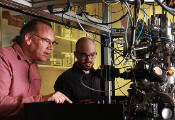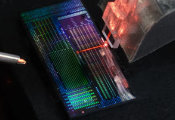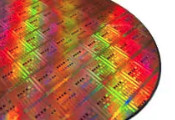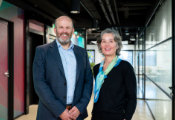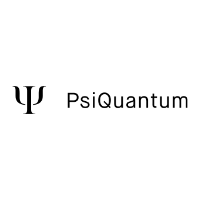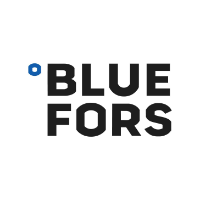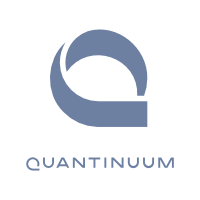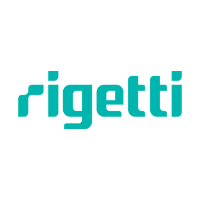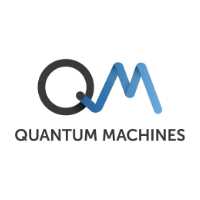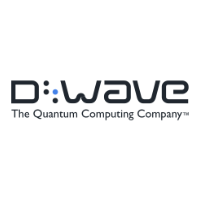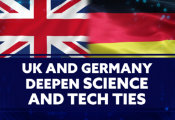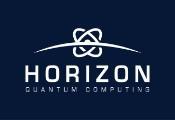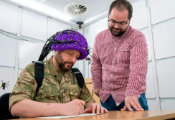A New Dimension for Spin Qubits in Diamond
October 29, 2025 -- The path toward realizing practical quantum technologies begins with understanding the fundamental physics that govern quantum behavior — and how those phenomena can be harnessed in real materials. In the lab of Ania Jayich, Bruker Endowed Chair in Science and Engineering, Elings Chair in Quantum Science, and co-director of UC Santa Barbara’s National Science Foundation Quantum Foundry, that material of choice is laboratory-grown diamond.
Working at the intersection of materials science and quantum physics, Jayich and her team explore how engineered defects in diamond — known as spin qubits — can be used for quantum sensing. Among the lab’s standout researchers, Lillian Hughes, who recently earned her Ph.D. and will soon begin postdoctoral work at the California Institute of Technology, has achieved a major advance in this effort.
In a series of three papers co-authored with Jayich — one published in PRX in March and the second and third in Nature in October — Hughes demonstrates, for the first time, how not just individual qubits but two-dimensional ensembles of many defects can be arranged and entangled within diamond. This breakthrough enables the realization of a metrological quantum advantage in the solid state, marking an important step toward the next generation of quantum technologies.
Well-designed defects
“We can create a configuration of nitrogen-vacancy (NV) center spins in the diamonds with control over their density and dimensionality, such that they are densely packed and depth-confined into a 2D layer,” Hughes said. “And because we can design how the defects are oriented, we can engineer them to exhibit non-zero dipolar interactions.” This accomplishment was the subject of the PRX paper, titled “A strongly interacting, two-dimensional, dipolar spin ensemble in (111)-oriented diamond.”
The NV center in diamond consists of a nitrogen atom, which substitutes for a carbon atom, and an adjacent, missing carbon atom (the vacancy).“The NV center defect has a few properties, one of which is a degree of freedom called a spin — a fundamentally quantum mechanical concept. In the case of the NV center, the spin is very long lived,” Jayich said. “These long-lived spin states make NV centers useful for quantum sensing. The spin couples to the magnetic field that we’re trying to sense.”
The ability to use the spin degree of freedom as a sensor has been around since the 1970s’ invention of magnetic resonance imaging (MRI), explained Jayich, noting that the MRI works by manipulating the alignment and energy states of protons and then detecting the signals they emit as they return to equilibrium, creating an image of some part of the internal body.
“Previous quantum-sensing experiments conducted in a solid-state system have all made use of single spins or non-interacting spin ensembles,” Jayich said. “What’s new here is that, because Lillian was able to grow and engineer these very strongly interacting dense spin ensembles, we can actually leverage the collective behavior, which provides an extra quantum advantage, allowing us to use the phenomena of quantum entanglement to get improved signal-to-noise ratios, providing greater sensitivity and making a better measurement possible.”
The type of entanglement-assisted sensing that Hughes’s work enables has been demonstrated previously in gas-phase atomic systems. “Ideally, for many target applications, your sensor should be easy to integrate and to bring close to the system under study,” Jayich said. “It is much easier to do that with a solid-state material, like diamond, than gas-phase atomic sensors on which, for instance, GPS is based. Furthermore, atomic sensors require significant auxiliary hardware to confine and control, such as vacuum chambers and numerous lasers, making it hard to bring an atomic sensor within nanometer-scale proximity to a protein, for instance, prohibiting high-spatial-resolution imaging.”
In the Jayich lab, the focus is on using diamond sensors to look at material-based electronic effects and phenomena. But, analogous to placing a solid-state sensor into a cell, Jayich said, “You can place material targets into nanometer-scale proximity of a diamond surface, thus bringing them really close to sub-surface NV centers. So it’s very easy to integrate this type of diamond quantum sensor with a variety of interesting target systems. That’s a big reason why this platform is so exciting.”
“A solid-state magnetic sensor of this kind could be very useful for probing, for instance, biological systems,” Jayich said. “Nuclear magnetic resonance [NMR] is based on detecting very small magnetic fields coming from the constituent atoms in, for example, biological systems. Such an approach is also useful if you want to understand new materials, whether electronic materials, superconducting materials, or magnetic materials that could be useful for a variety of applications.”
Squeezing
Any measurement contains associated noise that limits the measurement to some degree of precision. One fundamental source of noise, called quantum projection noise, limits measurement precision to a value called the standard quantum limit, a value that is classically reduced by the square root of N, the number of quantum sensors used in the measurement. If, however, one can engineer a particular form of interactions between the sensors, it becomes possible to break the standard quantum limit for N unentangled sensors. One clever way to do that is to “squeeze” the amplitude of the noise by inducing correlations among the particles and producing a spin-squeezed state.
“It’s as if you were trying to measure something with a meter stick having gradations a centimeter apart; those centimeter-spaced gradations are effectively the amplitude of the noise in your measurement. You would not use such a meter stick to measure the size of an amoeba, which is much smaller than a centimeter,” Jayich said. “By squeezing — silencing the noise — you effectively use quantum mechanical interactions to ‘squish’ that meter stick, effectively creating finer gradations and allowing you to measure smaller things more precisely.”
The second paper describes another type of metrological gain that can be achieved by using the same system, in this case, amplifying the signal strength without increasing the noise level to make a better measurement. In terms of the amoeba example given above, amplifying the signal has the effect of making the amoeba bigger so that the measuring stick with its one-centimeter gradation can now be used to measure it.
In terms of eventual real-world applications, Jayich said, “I don't think the foreseen technical challenges will prevent demonstrating a quantum advantage in a useful sensing experiment in the near future. It’s mostly about making the signal amplification stronger or increasing the amount of squeezing. One way to do that is to control the position of the spins in the 2Dxy plane, forming a regular array.
“There’s a materials challenge here, in that, because we can't dictate exactly where the spins will incorporate, they incorporate in somewhat random fashion within a plane,” Jayich added. “That’s something we’re working on now, so that eventually we can have a grid of these spins, each placed a specific distance from each other. That would address an outstanding challenge to realizing practical quantum advantage in sensing.”


